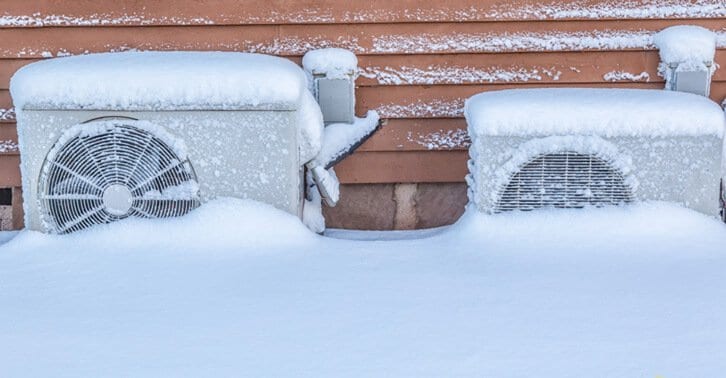Dealing with a Frozen AC Pipe: Expert Advice
Dealing with a Frozen AC Pipe: Expert Advice
Blog Article
Everyone maintains their own unique way of thinking on the subject of Why Is Ice On My Outside Air Conditione.

Introduction
Finding that your air conditioner pipe is iced up can be worrying, especially during warm summer months when you rely on your air conditioner the most. Recognizing what to do in such a circumstance is crucial to stop more damages to your cooling system and ensure your convenience inside your home.
Recognizing the Causes
Numerous elements can contribute to the freezing of an air conditioning pipe. Understanding these reasons can assist you resolve the issue properly.
Lack of Airflow
One typical source of an icy a/c pipeline is inadequate air flow. When the air flow over the evaporator coil is limited, it can cause the coil to go down below freezing temperature, resulting in ice development on the pipeline.
Reduced Refrigerant Levels
Insufficient cooling agent degrees in your AC system can additionally result in a frozen pipeline. Reduced refrigerant degrees can create the pressure in the system to go down, causing the cold of moisture on the evaporator coil.
Cold Weather Conditions
In colder environments, freezing temperatures outside can contribute to the cold of AC pipelines. If your AC device is not properly shielded or if there are leaks in the ductwork, chilly air can infiltrate the system, triggering the pipeline to ice up.
Dirty Air Filters
Filthy or clogged up air filters can restrict airflow in your air conditioner system, leading to numerous concerns, consisting of a frozen pipe. It's vital to change or cleanse your air filters regularly to guarantee proper air flow and avoid ice accumulation.
Indications of a Frozen Air Conditioning Pipe
Recognizing the indicators of an icy air conditioner pipeline is crucial for timely activity.
Lowered Airflow
If you see a significant decrease in air movement from your vents, it might indicate an icy pipe.
Ice Buildup on the Pipe
Noticeable ice build-up on the cooling agent line or the evaporator coil is a clear sign of an icy AC pipe.
Weird Sounds from the Unit
Uncommon noises, such as hissing or bubbling, coming from your air conditioning device can signal that there's ice present on the pipe.
Immediate Actions to Take
When confronted with a frozen air conditioner pipe, it's important to act swiftly to prevent further damages to your cooling system.
Turning off the a/c
The first step is to switch off your air conditioning system to prevent the system from running and exacerbating the problem.
Checking for Blockages
Inspect the area around the indoor device for any blockages that may be obstructing air movement, such as furnishings or curtains.
Thawing the Pipe
You can utilize mild methods like placing towels taken in cozy water around the icy pipeline to assist thaw it slowly.
Safety nets
Taking preventive measures can help prevent future events of an icy a/c pipeline.
When DIY Methods Fail
If your efforts to thaw the pipeline or address various other issues are not successful, it's time to call in a professional.
Significance of Hiring a Professional HVAC Technician
A qualified HVAC service technician has the competence and tools necessary to identify and repair problems with your air conditioner system safely and efficiently.
Routine Maintenance Checks
Arrange routine maintenance checks with an expert HVAC service technician to guarantee that your air conditioning system is running efficiently.
Transforming Air Filters
Consistently change or clean your air filters to stop air movement restrictions and keep ideal efficiency.
Shielding Exposed Pipes
If your a/c pipes are revealed to cold temperatures, take into consideration insulating them to avoid freezing throughout winter months.
Seeking Professional Help
If DIY techniques stop working to resolve the problem or if you're unclear regarding exactly how to continue, it's finest to look for support from a certified HVAC specialist.
Verdict
Dealing with a frozen a/c pipeline can be an aggravating experience, but recognizing just how to react can assist reduce damages and recover comfort to your home. By comprehending the reasons, acknowledging the signs, and taking timely activity, you can efficiently resolve the concern and protect against future incidents.
What to Do If Your AC Line Is Frozen
Make Sure All Supply and Return Air Vents Are Open
If you notice problems with airflow, the first thing you should do is check your supply and return vents. Supply vents distribute clean, conditioned air throughout your home. As this air becomes stale, it’s pulled into the return vent, where it’s reconditioned before being sent back out through the supply vent.
When these vents are closed, air won’t flow in the home. Before examining your AC, check the vents in every room and ensure they’re all open.
Check for a Dirty Air Filter
Another possible cause of limited airflow is a dirty air filter. Your air conditioner’s filters catch elements you don’t want to breathe in, such as dirt and dust. Over time, filters can become clogged, ultimately blocking air from flowing in and out. The lack of airflow can then cause the entire coil to freeze and will completely restrict any air from moving through it. The AC may need to be powered off for one to two days to allow the coil to thaw after replacing the filter to allow proper functioning of the unit. This debris can also accumulate on your AC’s evaporator coil, requiring a more serious repair. In general, air filters should be cleaned regularly (about every two weeks).
Assess Your Outdoor Unit
In addition to checking your AC, assessing the outdoor unit is a good idea. Also known as the condensing unit, it works with your interior unit to release heat outside. An issue with the outdoor unit can result in rising internal temperatures.
Overgrown Shrubs or Clogged Leaves
From leaves and twigs to shrubs and debris, there’s no shortage of outdoor elements that can accumulate around your condensing unit. When these elements get lodged inside the unit, they can block airflow. Fortunately, removing the blockage can solve the problem.
Sounds of a Broken Fan
Shrubs and leaves aren’t the only things that can impede your outdoor unit’s airflow. If the fan is broken, the unit won’t be able to properly get rid of heat — which means the internal temperature won’t go down. First, make sure the fan is spinning. If it is, check for the following sounds of a broken fan:
Buzzing Rattling Screeching Hissing Clicking Preventative Measures
Nobody wants to deal with a frozen AC line. In addition to causing problems with your air conditioner, they require professional repairs. On the bright side, there are preventative measures you can take to help ensure this issue doesn’t arise in the first place.
https://www.coopergreenteam.com/blog/what-to-do-if-ac-line-frozen

Do you like reading about How can I fix an air conditioner’s frozen pipe?? Place a remark below. We would be delighted to know your reactions about this write up. Hoping to see you back again in the future. Do you know about another person who is sincerely interested in the topic? Be sure share it. I am grateful for your time. Visit again soon.
Book 24/7 Report this page